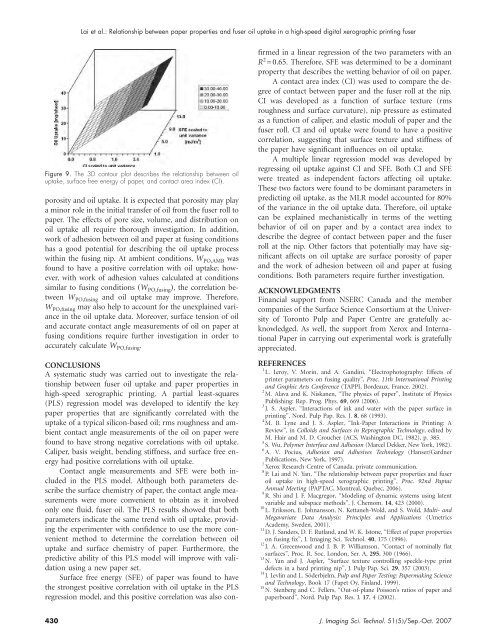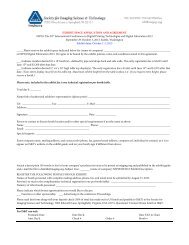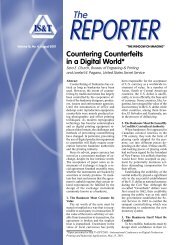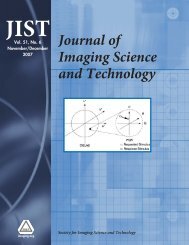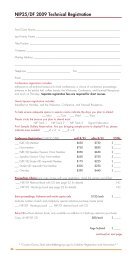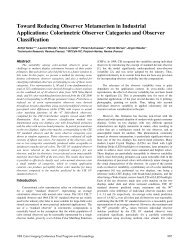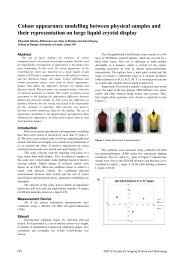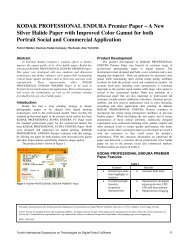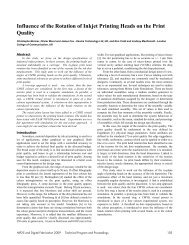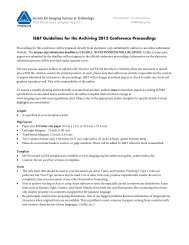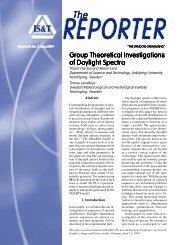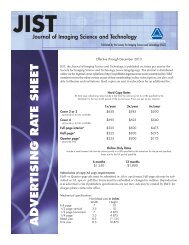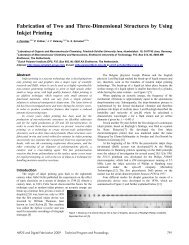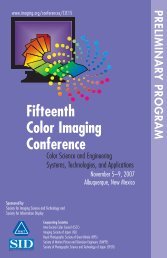JIST - Society for Imaging Science and Technology
JIST - Society for Imaging Science and Technology
JIST - Society for Imaging Science and Technology
Create successful ePaper yourself
Turn your PDF publications into a flip-book with our unique Google optimized e-Paper software.
Lai et al.: Relationship between paper properties <strong>and</strong> fuser oil uptake in a high-speed digital xerographic printing fuser<br />
Figure 9. The 3D contour plot describes the relationship between oil<br />
uptake, surface free energy of paper, <strong>and</strong> contact area index CI.<br />
porosity <strong>and</strong> oil uptake. It is expected that porosity may play<br />
a minor role in the initial transfer of oil from the fuser roll to<br />
paper. The effects of pore size, volume, <strong>and</strong> distribution on<br />
oil uptake all require thorough investigation. In addition,<br />
work of adhesion between oil <strong>and</strong> paper at fusing conditions<br />
has a good potential <strong>for</strong> describing the oil uptake process<br />
within the fusing nip. At ambient conditions, W PO,AMB was<br />
found to have a positive correlation with oil uptake; however,<br />
with work of adhesion values calculated at conditions<br />
similar to fusing conditions W PO,fusing , the correlation between<br />
W PO,fusing <strong>and</strong> oil uptake may improve. There<strong>for</strong>e,<br />
W PO,fusing may also help to account <strong>for</strong> the unexplained variance<br />
in the oil uptake data. Moreover, surface tension of oil<br />
<strong>and</strong> accurate contact angle measurements of oil on paper at<br />
fusing conditions require further investigation in order to<br />
accurately calculate W PO,fusing .<br />
CONCLUSIONS<br />
A systematic study was carried out to investigate the relationship<br />
between fuser oil uptake <strong>and</strong> paper properties in<br />
high-speed xerographic printing. A partial least-squares<br />
(PLS) regression model was developed to identify the key<br />
paper properties that are significantly correlated with the<br />
uptake of a typical silicon-based oil; rms roughness <strong>and</strong> ambient<br />
contact angle measurements of the oil on paper were<br />
found to have strong negative correlations with oil uptake.<br />
Caliper, basis weight, bending stiffness, <strong>and</strong> surface free energy<br />
had positive correlations with oil uptake.<br />
Contact angle measurements <strong>and</strong> SFE were both included<br />
in the PLS model. Although both parameters describe<br />
the surface chemistry of paper, the contact angle measurements<br />
were more convenient to obtain as it involved<br />
only one fluid, fuser oil. The PLS results showed that both<br />
parameters indicate the same trend with oil uptake, providing<br />
the experimenter with confidence to use the more convenient<br />
method to determine the correlation between oil<br />
uptake <strong>and</strong> surface chemistry of paper. Furthermore, the<br />
predictive ability of this PLS model will improve with validation<br />
using a new paper set.<br />
Surface free energy (SFE) of paper was found to have<br />
the strongest positive correlation with oil uptake in the PLS<br />
regression model, <strong>and</strong> this positive correlation was also confirmed<br />
in a linear regression of the two parameters with an<br />
R 2 =0.65. There<strong>for</strong>e, SFE was determined to be a dominant<br />
property that describes the wetting behavior of oil on paper.<br />
A contact area index (CI) was used to compare the degree<br />
of contact between paper <strong>and</strong> the fuser roll at the nip.<br />
CI was developed as a function of surface texture (rms<br />
roughness <strong>and</strong> surface curvature), nip pressure as estimated<br />
as a function of caliper, <strong>and</strong> elastic moduli of paper <strong>and</strong> the<br />
fuser roll. CI <strong>and</strong> oil uptake were found to have a positive<br />
correlation, suggesting that surface texture <strong>and</strong> stiffness of<br />
the paper have significant influences on oil uptake.<br />
A multiple linear regression model was developed by<br />
regressing oil uptake against CI <strong>and</strong> SFE. Both CI <strong>and</strong> SFE<br />
were treated as independent factors affecting oil uptake.<br />
These two factors were found to be dominant parameters in<br />
predicting oil uptake, as the MLR model accounted <strong>for</strong> 80%<br />
of the variance in the oil uptake data. There<strong>for</strong>e, oil uptake<br />
can be explained mechanistically in terms of the wetting<br />
behavior of oil on paper <strong>and</strong> by a contact area index to<br />
describe the degree of contact between paper <strong>and</strong> the fuser<br />
roll at the nip. Other factors that potentially may have significant<br />
affects on oil uptake are surface porosity of paper<br />
<strong>and</strong> the work of adhesion between oil <strong>and</strong> paper at fusing<br />
conditions. Both parameters require further investigation.<br />
ACKNOWLEDGMENTS<br />
Financial support from NSERC Canada <strong>and</strong> the member<br />
companies of the Surface <strong>Science</strong> Consortium at the University<br />
of Toronto Pulp <strong>and</strong> Paper Centre are gratefully acknowledged.<br />
As well, the support from Xerox <strong>and</strong> International<br />
Paper in carrying out experimental work is gratefully<br />
appreciated.<br />
REFERENCES<br />
1 L. Leroy, V. Morin, <strong>and</strong> A. G<strong>and</strong>ini, “Electrophotography: Effects of<br />
printer parameters on fusing quality”, Proc. 11th International Printing<br />
<strong>and</strong> Graphic Arts Conference (TAPPI, Bordeaux, France, 2002).<br />
2 M. Alava <strong>and</strong> K. Niskanen, “The physics of paper”, Institute of Physics<br />
Publishing: Rep. Prog. Phys. 69, 669 (2006).<br />
3 J. S. Aspler, “Interactions of ink <strong>and</strong> water with the paper surface in<br />
printing”, Nord. Pulp Pap. Res. J. 8, 68 (1993).<br />
4 M. B. Lyne <strong>and</strong> J. S. Aspler, “Ink-Paper Interactions in Printing: A<br />
Review”, in Colloids <strong>and</strong> Surfaces in Reprographic <strong>Technology</strong>, edited by<br />
M. Hair <strong>and</strong> M. D. Croucher (ACS, Washington DC, 1982), p. 385.<br />
5 S. Wu, Polymer Interface <strong>and</strong> Adhesion (Marcel Dekker, New York, 1982).<br />
6 A. V. Pocius, Adhesion <strong>and</strong> Adhesives <strong>Technology</strong> (Hanser/Gardner<br />
Publications, New York, 1997).<br />
7 Xerox Research Centre of Canada, private communication.<br />
8 P. Lai <strong>and</strong> N. Yan, “The relationship between paper properties <strong>and</strong> fuser<br />
oil uptake in high-speed xerographic printing”, Proc. 92nd Paptac<br />
Annual Meeting (PAPTAC, Montreal, Quebec, 2006).<br />
9 R. Shi <strong>and</strong> J. F. Macgregor, “Modeling of dynamic systems using latent<br />
variable <strong>and</strong> subspace methods”, J. Chemom. 14, 423 (2000).<br />
10 L. Eriksson, E. Johnansson, N. Kettaneh-Wold, <strong>and</strong> S. Wold, Multi- <strong>and</strong><br />
Megavariate Data Analysis: Principles <strong>and</strong> Applications (Umetrics<br />
Academy, Sweden, 2001).<br />
11 D. J. S<strong>and</strong>ers, D. F. Rutl<strong>and</strong>, <strong>and</strong> W. K. Istone, “Effect of paper properties<br />
on fusing fix”, J. <strong>Imaging</strong> Sci. Technol. 40, 175 (1996).<br />
12 J. A. Greeenwood <strong>and</strong> J. B. P. Williamson, “Contact of nominally flat<br />
surfaces”, Proc. R. Soc. London, Ser. A, 295, 300 (1966).<br />
13 N. Yan <strong>and</strong> J. Aspler, “Surface texture controlling speckle-type print<br />
defects in a hard printing nip”, J. Pulp Pap. Sci. 29, 357 (2003).<br />
14 J. Levlin <strong>and</strong> L. Söderbjelm, Pulp <strong>and</strong> Paper Testing: Papermaking <strong>Science</strong><br />
<strong>and</strong> <strong>Technology</strong>, Book 17 (Fapet Oy, Finl<strong>and</strong>, 1999).<br />
15 N. Stenberg <strong>and</strong> C. Fellers, “Out-of-plane Poisson’s ratios of paper <strong>and</strong><br />
paperboard”, Nord. Pulp Pap. Res. J. 17, 4 (2002).<br />
430 J. <strong>Imaging</strong> Sci. Technol. 515/Sep.-Oct. 2007


